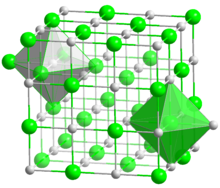This is an old revision of this page, as edited by Alph Bot (talk | contribs) at 14:51, 18 May 2011 (r2.7.1) (robot Modifying: vi:Côban (II) ôxít). The present address (URL) is a permanent link to this revision, which may differ significantly from the current revision.
Revision as of 14:51, 18 May 2011 by Alph Bot (talk | contribs) (r2.7.1) (robot Modifying: vi:Côban (II) ôxít)(diff) ← Previous revision | Latest revision (diff) | Newer revision → (diff)
| |
| Names | |
|---|---|
| IUPAC name Cobalt(II) oxide | |
| Other names
Cobaltous oxide Cobalt monoxide | |
| Identifiers | |
| CAS Number | |
| 3D model (JSmol) | |
| ChemSpider | |
| ECHA InfoCard | 100.013.777 |
| EC Number |
|
| PubChem CID | |
| RTECS number |
|
| UN number | 3288 |
| CompTox Dashboard (EPA) | |
InChI
| |
SMILES
| |
| Properties | |
| Chemical formula | CoO |
| Molar mass | 74.9326 g/mol |
| Appearance | black powder |
| Odor | odorless |
| Density | 6.44 g/cm |
| Melting point | 1,933 °C (3,511 °F; 2,206 K) |
| Solubility in water | insoluble in water |
| Structure | |
| Crystal structure | cubic, cF8 |
| Space group | Fm3m, No. 225 |
| Hazards | |
| Flash point | Non-flammable |
| Lethal dose or concentration (LD, LC): | |
| LD50 (median dose) | 202 mg/kg |
| Related compounds | |
| Other anions | Cobalt(II) sulfide Cobalt(II) hydroxide |
| Other cations | Iron(II) oxide Nickel(II) oxide |
| Except where otherwise noted, data are given for materials in their standard state (at 25 °C , 100 kPa).
| |
Cobalt(II) oxide or cobalt monoxide is an inorganic compound that appears as olive-green to red crystals, or as a greyish or black powder. It is used extensively in the ceramics industry as an additive to create blue colored glazes and enamels as well as in the chemical industry for producing cobalt(II) salts.
Structure and properties
CoO crystals adopt the periclase (rock salt) structure with a lattice constant of 4.2615Å.
It is antiferromagnetic below 16°C .
Preparation
Cobalt(II,III) oxide decomposes to cobalt(II) oxide at 950 °C:
- 2 Co3O4 → 6 CoO + O2
Though commercially available, cobalt(II) oxide may be prepared in the laboratory by electrolyzing a solution of cobalt(II) chloride:
CoCl2 + H2O → CoO + H2 + Cl2
It may also be prepared by precipitating the hydroxide, followed by thermal decomposition:
- CoX + 2 NaOH → Co(OH)2 + Na2X
- Co(OH)2 → CoO + H2O
Reactions
As can be expected, cobalt(II) oxide reacts with mineral acids to form the corresponding cobalt salts:
- CoO + 2 HX → CoX2 + H2O
Applications
Cobalt(II) oxide has for centuries used as a coloring agent on kiln fired pottery; the earliest examples go back to 12th century German pottery. The additive provides a deep shade of blue named Cobalt blue. The band gap (CoO) is around 2.4 eV. It also is used in cobalt blue glass.
References
- Patnaik, Pradyot (2003). Handbook of Inorganic Chemical Compounds. McGraw-Hill. ISBN 0070494398. Retrieved 2009-06-06.
- http://www.alfa.com/content/msds/german/44354.pdf
- "Safety (MSDS) data for cobalt oxide". The Physical and Theoretical Chemistry Laboratory, Oxford University. Retrieved 2008-11-11.
- Kannan, R.; Seehra, Mohindar S. (1987). "Percolation effects and magnetic properties of the randomly diluted fcc system CopMg1-pO". Physical Review B. 35: 6847. doi:10.1103/PhysRevB.35.6847.
{{cite journal}}: CS1 maint: multiple names: authors list (link) - Silinsky, P. S.; Seehra, Mohindar S. (1981). "Principal magnetic susceptibilities and uniaxial stress experiments in CoO". Physical Review B. 24: 419. doi:10.1103/PhysRevB.24.419.
{{cite journal}}: CS1 maint: multiple names: authors list (link) - Process for making a cobalt oxide catalyst, James, Leonard E. (Richmond, VA) Crescentini, Lamberto (Chester, VA) Fisher, William B. (Chester, VA) 1983. http://www.freepatentsonline.com/4389339.html
- Kern, S.; J. Chem. Soc.; 1876. Part 1. p880.
- Zamek, Jeff: "A Problem With Cobalt?" Ceramics Today http://www.ceramicstoday.com/articles/zamek_cobalt.htm
| Cobalt compounds | |
|---|---|
| Cobalt(I) | |
| Cobalt(II) | |
| Cobalt(0,III) | |
| Cobalt(II,III) | |
| Cobalt(III) | |
| Cobalt(III,IV) | |
| Cobalt(IV) | |
| Cobalt(V) | |
This inorganic compound–related article is a stub. You can help Misplaced Pages by expanding it. |